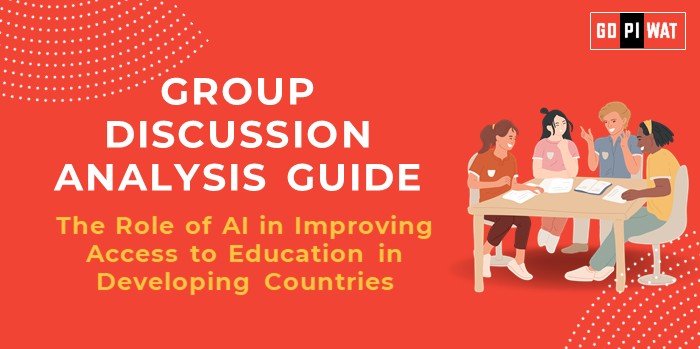📋 Group Discussion (GD) Analysis Guide: The Role of AI in Improving Access to Education in Developing Countries
🌐 Introduction to the Topic
Opening Context: “Artificial Intelligence (AI) is revolutionizing education worldwide, particularly in developing nations where it bridges gaps in access, affordability, and quality.”
Topic Background: AI’s application in education spans adaptive learning platforms, automated administrative tasks, and content localization. The push for equitable access to education aligns with UNESCO’s Sustainable Development Goals, especially Goal 4: Quality Education.
📊 Quick Facts and Key Statistics
- 📈 Global Learning Poverty: 90% in Sub-Saharan Africa, compared to 40% in South Asia (World Bank, 2023).
- 📉 EdTech Growth: The global AI in education market is expected to reach $20 billion by 2027, showcasing its expanding role.
- 🌐 Digital Divide: Over 60% of students in developing nations lack internet access, emphasizing AI’s role in bridging connectivity gaps.
- 🗣️ Language Inclusivity: AI-enabled tools now support over 1,000 local languages, enhancing accessibility.
👥 Stakeholders and Their Roles
- 🏛️ Governments: Policy formulation and digital infrastructure investment.
- 💻 EdTech Companies: Creating scalable AI-based educational solutions.
- 🌍 NGOs: Deploying grassroots projects for underserved regions.
- 🎓 Students and Educators: Benefiting from enhanced resources and personalized learning.
🏆 Achievements and Challenges
✨ Achievements:
- Localized Learning: AI-driven platforms like Duolingo provide multilingual support, bridging language barriers.
- Adaptive Learning: Tools like Khan Academy’s AI systems personalize learning paths for students.
- Cost Efficiency: Automated administrative systems reduce operational costs in schools.
⚠️ Challenges:
- Digital Infrastructure: Internet and device availability remain low in rural areas.
- Cultural Acceptance: Limited awareness and skepticism hinder adoption.
- Data Privacy Concerns: AI solutions must address issues of ethical data use.
🌍 Global Comparisons:
- China: Pioneering AI-based smart classrooms.
- Estonia: Extensive e-education programs integrating AI tools for primary education.
📚 Case Studies:
- India’s BYJU’S: Leveraging AI for tailored learning modules, significantly improving learning outcomes.
- Rwanda’s Smart Classroom Project: AI tools combined with solar-powered devices for remote learning.
🗣️ Structured Arguments for Discussion
- ✅ Supporting Stance: “AI transforms education by providing affordable, localized, and personalized learning experiences, essential for developing nations.”
- ❌ Opposing Stance: “Without robust infrastructure and data security measures, AI’s educational potential cannot be fully realized.”
- ⚖️ Balanced Perspective: “AI has vast potential to democratize education, but infrastructural challenges and cultural barriers must be addressed.”
💡 Effective Discussion Approaches
- 📢 Opening Approaches:
- “AI bridges the education gap for 250 million out-of-school children globally.”
- “China and India demonstrate how AI enhances scalable education in resource-scarce settings.”
- 🛡️ Counter-Argument Handling:
- “While infrastructure is a challenge, scalable solutions like low-bandwidth AI platforms can address these gaps.”
📌 Strategic Analysis of Strengths and Weaknesses
- 💪 Strengths: Scalability, cost-efficiency, personalization.
- ⚠️ Weaknesses: Dependence on internet, ethical concerns.
- 🌟 Opportunities: Policy integration, private-public partnerships.
- 🚨 Threats: Data breaches, uneven resource distribution.
🎯 Connecting with B-School Applications
- 💡 Real-World Applications: AI in education can inspire projects on social entrepreneurship and technological innovation in operations.
- ❓ Sample Interview Questions:
- “What strategies can enhance AI adoption in rural education?”
- “How does AI-driven education align with sustainable development?”
- 🧠 Insights for B-School Students: Explore the intersection of AI with social impact, particularly in education technology ventures.


